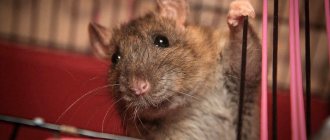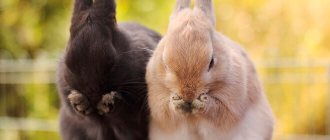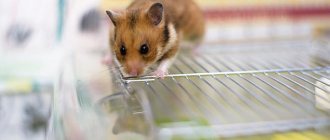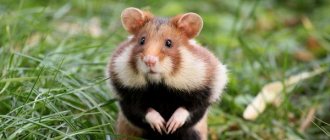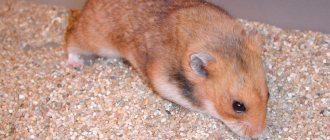Features and lifestyle
Among its relatives, the Syrian hamster is the largest, its length reaches 18 cm. Females are larger in size than males and can grow 20 cm long. Distinctive features of the animal:
- rounded ears;
- stocky body;
- small paws;
- round muzzle;
- There are four toes on the front paws and five on the hind paws.
Syrian hamsters also live in the wild and are not picky about where they live. They can be found in Asia, Africa and America. The most favorable place for an animal to live is in crop fields, where there is a lot of food. The animals live in shallow burrows. They lead an active lifestyle at night.
The only type of hamster that can be trained to a nickname. He has a well-developed intellect and friendly habits. A seemingly cute animal can be aggressive! It is common for rodents to bite. Why does he do this?
- Knows the world . If you pick up a hamster for the first time, he will definitely bite. This is how a Syrian gets to know you. Nature endowed him with hearing and smell poorly, but his tactile sense is well developed. To get to know something better, he will definitely taste it.
- Feels food . Let's say you've eaten and picked up the animal. The smell of your food is new to him, and he definitely tastes it.
- You are not lifting the hamster correctly. You need to take the animal with your hands from the side or from below. If you grab him from above he will get scared.
- Loud sounds. When you have a hamster in your hands, do not speak loudly, act calmly, he will feel it and will be kind.
- Sharpenes his teeth. If there is a lack of mineral stone or dry branches, which the animal needs to grind down its teeth, it will bite.
Features of behavior
The animals are quite noisy, although they are most active at night and you need to be prepared for this.
One of my favorite activities is washing, a rather entertaining and funny sight. Before starting to clean itself, the pet licks its paws, which it then rubs on its cute face and body.
The animal combs its fur coat with its claws. He always has it clean and tidy. By the way, cleaning occurs not so much out of love for cleanliness, but for more practical reasons: a smooth hairstyle retains heat better than tousled and tangled hair.
If your pet gets cold, he will build himself a cozy nest of sawdust, burying himself in it up to his ears. In hotter weather, all the litter will be scattered.
Hamsters often get scared; at the moment of fright, they rush around the corners, press themselves to the floor and raise their small tail up. In moments of danger, it stands on its hind legs and bares its mouth, and can whistle and squeal. At this moment it is better not to pick him up - a bite cannot be avoided.
An animal can also stand on its paws out of curiosity, and will certainly reach out with its front paw towards an object of interest in order to examine it. At the same time, he seems to be listening and sniffing, funnyly turning his cute head.
Types and colors.
The true color of the Syrian hamster is red, more like a mahogany shade. It was this kind of inhabitant that was first discovered in Syria and brought to Europe. Its peculiarity: gray ears and black eyes. With age, the color of the animal changes, the undercoats become grayer, but the golden hue of the top remains the same. There are other colors of the animal:
- The black by deep charcoal hair color, white paws and chin. It appeared in France in the process of mutation.
- The white animal has red eyes and gray ears.
- The color “ivory” is very similar to white, but has a distinctive feature. A milk hamster can have either black or red eyes.
- The gray animal has dark gray ears, stripes on its cheeks, and a gray spot on its chest. The coat itself is light in color with dark tips. The undercoat is blue.
As a result of mixing, other shades were obtained:
- Honey
- Smoky
- Blue mink
- Yellow
- Cream
- Chocolate
- Brown
- Beige
Syrian Hamster Yellow
Syrian hamster Cream
Syrian hamster Smoky
Syrian hamster Blue mink
Syrian Hamster Beige
Syrian Hamster Brown
Syrian Hamster Honey
Hamster can be spotted. Currently, the Angora breed has been bred to have long fluffy hair.
How long do hamsters live?
The average lifespan of a hamster is 3 years. In the wild, rodents rarely live past the age of two. In order for an animal to be healthy, it needs to be provided with good conditions. Particular attention should be paid to the cage and food.
Cage requirements:
- It must be big. Although the animal is small, it requires space. The hamster loves to run, bury itself in sawdust, and look for food. Create for him the conditions of an endless field within the apartment. If you plan to have more than one animal, remember that Syrian hamsters must live separately. You can put two cells next to each other, but you shouldn’t put them together.
- Good ventilation is of no little importance. It is better to choose a cage from metal bars. Bacteria multiply quickly in an aquarium and plastic houses, which will only harm your pet’s health.
- Ease of cleaning and maintenance. Plastic cages are the most difficult to clean.
- Stock up on an extra house for your hamster. The animal can be transplanted into it when cleaning is required.
- The bottom of the cage should be uniform. A grate on the floor is not comfortable for your pet, as its nails will get caught.
- Consider a place to play, relax and eat.
- Choose the space between the rods no more than 2 cm, otherwise the animal will easily escape.
Siberian hamster at home
The Siberian hamster at home is an unpretentious animal. It can live in a cage and will comfortably set up its burrow in an aquarium. It is unpretentious in nutrition and does not require strict air temperature for maintenance. In comfortable conditions they live up to 4 years, with proper care and maintenance. The age of the hamster does not affect mobility; an “elderly” rodent is as active as a young one.
Features of keeping and caring for a hamster
A hamster, like any other pet, needs proper care. How to care for hamsters? The cage for it should be:
- Spacious so that he can move comfortably, you can arrange a second floor, he will be happy to explore the space. If the cage is not very large, put a running wheel in it. Without movement, the hamster quickly gets fat and gets sick.
- The gaps between the bars of the cage should be no more than 8 mm, otherwise the furry pet will definitely try to escape.
- Easy to clean. The bedding in the cage needs to be changed every 1-2 days, so it is important that this can be done easily and conveniently. Aspen sawdust or white paper are best suited for bedding; paper with dyes should not be used, as the paint composition is harmful to the animal.
You can place the rodent in an aquarium of suitable size, so it will not have a chance to escape. But cleaning an aquarium is more difficult than cleaning a cage.
During cleaning, the pet should be placed in a container or allowed to run around the house in a special wheel (one of the household should monitor the animal during this time). Hamsters do not like encroachments on their territory, so they can be aggressive if you start cleaning in their presence.
The location for the cage is chosen away from heat devices and direct sunlight (bright light irritates blind eyes); direct proximity to household appliances is undesirable, since rodents are sensitive to sharp sounds and detect ultrasound. Such content will be the most comfortable for the pet.
If you plan to raise offspring, you can keep two hamsters in one cage at once, but introduce them to each other as early as possible, preferably from childhood. They may need two houses as they like privacy. Hamsters reproduce quickly. If you do not need numerous offspring, then it is better to keep rodents in adjacent cages or in a cage with a partition.
What to feed a hamster?
The diet of an animal in a wild and domestic environment is significantly different. To keep your furry friend healthy, you should refrain from:
- Sweet
- Fat
- Salty
The hamster's body cannot digest sugar; if you overfeed it with junk food, it will not live long. In addition, I will gain a lot of weight.
The animal's main diet includes berries, small branches, and vegetables. You can find a huge range of food in stores. But all this is dry food. To be healthy, your pet needs fresh vegetables and fruits:
- Carrot
- Pumpkin
- Turnip
- Salad
- Zucchini
- Radish
- Pear
- Grape
- Persimmon
- Apple
You should not get carried away with potatoes, fruits, cabbage, as they contain sugar. It is better not to give citrus fruits, fermented milk, nuts, seeds, chocolate to the animal. The Syrian hamster loves flour: cereals, pasta, bread, as well as milk and boiled meat.
Under no circumstances should food be used for guinea pigs or other rodents! Everyone has their own diet, be careful!
How to determine gender?
The female and the male have their own distinctive characteristics not only in character, but also in appearance. Knowing the gender is important if you are going to keep several animals together. Two females in one house will never get along, but with males things are simpler. To avoid unexpected offspring, it’s worth finding out who you put in the same cage. It is better to determine the sex of an animal older than a month. Here are the main ways:
- In February it is easier to identify a male, since his testes are swollen and his testicles are more visible.
- The female has a rounded back, while the male has a sharp back. This difference is noticeable when viewed from above.
- The male has two nipples on the abdomen, and the female has four.
- If upon examination it appears that there is only one outlet, then it is definitely a girl. For boys, the distance between them is greater.
- The female's belly has denser fur.
Habitat in nature
The Siberian hamster's natural habitat is the northern steppe of Kazakhstan and the hilly terrain of Tuva, located in Siberia.
Rodents are nocturnal: in the dark they go out in search of food - this makes it easier for them to avoid encounters with predators (owls and foxes).
As a dwelling, they use self-dug burrows, consisting of a “closet” and a nest, connected to each other by tunnels. Several passages serve to communicate with the surface.
With the onset of cold weather and shortening daylight hours, the animals begin seasonal molting, when their brown fur coat changes to white. This is necessary for camouflage - a snow-white baby is difficult to notice in the snow.
Siberian hamsters have a keen sense of smell, acute hearing and poor eyesight, which is apparently associated with life underground. They recognize each other by the smell emitted by special glands located in the abdomen.
How to care?
Basic requirements for caring for a Syrian hamster:
- You need to clean the cage twice a week.
- Change the water once a day.
- The animal's cage must be equipped with a wheel, a feeder, a drinking bowl and a house where it will sleep. Fortunately, most manufacturers have already provided these conveniences.
- Sawdust 3 cm thick is placed at the bottom of the cage, where the animal cleans itself. It is not recommended to lay sawdust on long-haired hamsters; their fur may become matted. For these, it is better to use paper napkins or natural wood filler.
- For physical activity, it is necessary to install a “sports complex”, which consists of various obstacles, perches, and a large wheel. Hamsters gain weight very quickly; activity will not hurt them.
- A drinking bowl is required with a volume of 50 ml.
- Use a feeder about 7 cm wide.
- You need to feed your Syrian hamster 2 times a day: morning and evening.
- You cannot wash the animal. If you are worried about its cleanliness, then install a sand bath.
- It is better to comb long-haired individuals with a toothbrush.
- The animal can be let out for a walk around the house, but only if it is accustomed to being handled.
Watch your pet, keep the cage clean and tidy. It is important not to forget to change the water; water is an important source of nutrition for hamsters.
Appearance
In appearance, a hamster looks like a fluffy ball, the diameter of which does not exceed 7 cm. The average weight is 25 g, although at home they gain up to 50 g of live weight on free grub. The head is small, with round dark eyes and small black ears.
There are hairs on the soles of the paws; the limbs themselves are short and have five toes. The tail is almost invisible and covered with sparse hairs.
The summer color of the babies is black and gray, with a brown longitudinal stripe on the back. The belly, like all representatives of the hamster genus, is light, the ears are black.
Currently, geneticists have developed more interesting colors - pearl and sapphire.
In winter, the fur turns white, although seasonal shedding does not occur often at home.
How to tame?
It takes time for a hamster to get used to its new owner. Here are the basic rules for taming:
- Do not touch the hamster for several days, as soon as he gets used to the house, he will become more friendly.
- Place the cage in a crowded place, so the taming process will go faster.
- Hamsters often sleep during the day, so you don't need to wake him up, he will become irritable. Postpone your acquaintance to the evening.
- Talk to the animal, so it will quickly get used to your voice. Call him by name. Perhaps he will remember it faster.
- Offer your hamster a piece of biscuit through the cage and wait for him to show interest.
- Start hand feeding unobtrusively. Just place a treat in your palm and wait.
- Now you can try to pick up the animal, but do it from the side or from below. By taking the animal from above, you will scare it. The palm should form a cup, this is comfortable for both.
- For the first time, it is better to lift the hamster off the sofa or bed, so there is less chance of harming him if he falls. After all, the animal is very nimble and agile.
- While holding the animal, provide it with shelter by covering the top with your palm.
- You cannot pet the animal on the head, only on the back.
The main thing is to remain patient and not to grab an animal that runs away. This way the hamster will be scared of you forever and it will be very difficult to earn his trust. The taming process does not take much time - from two weeks to a month.
Important! Handle your pet only with clean hands! If he senses a foreign odor, he may bite.
What determines life expectancy?
In its natural habitat, the animal runs long distances and overcomes obstacles in search of food. The lifespan of a ward directly depends on his activity.
- The Syrian golden hamster is large in size compared to its relatives. A representative of this breed needs a large and spacious cage. In a cramped enclosure, the hamster will feel constrained and uncomfortable.
- To release the pet's energy, it is advisable to equip the enclosure with play complexes. Multi-level houses with manholes, hanging rings and swings will interest your pet. A running wheel can capture a hamster's attention for a long time. Having selected a model, the owner can count on the rodent to give itself free reign, remembering its instincts.
- Periodically, you need to take your pet out of the cage and give it the opportunity to walk around the house . To do this, you need to temporarily isolate other pets and remove the hamster from the cage. If there are hard-to-reach places in the room or a risk of getting lost, use a walking ball. In a playful way, the Syrian hamster will satisfy its curiosity and explore space.
You should not hope for a long life for an animal with minimal activity.
Reproduction.
It is better to mate a female at the age of four months, and a male at three months. The fetus is gestated for only eighteen days. Before birth, the cage must be thoroughly disinfected and cleaned. Either four or fifteen cubs can be born. They feed on mother's milk. After 28 days, they begin to get accustomed to adult food. Touching the offspring is prohibited. If the female smells a foreign odor, she will simply eat the young. A young mother needs to be fed more cottage cheese, yolk, and boiled chicken. You should not disturb the animal until the children grow up.
Briefly about breeding
It is very important to know and take into account the fact that Syrian hamsters do not prefer a family lifestyle - they are bachelors - loners, and they value this, this is their peculiarity. Therefore, they need to be kept separately. During the mating period, the male and female meet, do their business and quietly, peacefully disperse, as if nothing had happened.
Take this into account!
Diseases.
A sick hamster can be easily identified by its habits. He starts hiding and sleeps a lot. The coat becomes unkempt and disheveled. The animal is lethargic, does not play, does not eat or drink, loses weight, its eyes are closed. The main reasons for poor condition:
- Unfavourable conditions
- Poor nutrition
- Stress
Hamster diseases can be divided into those that are contagious to humans and those that are not. The first group includes:
- Infections
- Parasites
- Fungi
The source of infection can be a person, an animal, food, or bedding.
The most common diseases are:
- Lymphocytic choriomeningitis is transmitted from other animals. An adult hamster suffers from it asymptomatically, while young animals suffer from conjunctivitis and damage to the respiratory system. Therefore, it is often recommended not to purchase a hamster under three months old.
- Intestinal diseases accompanied by diarrhea. In this case, the animal dies from dehydration. To save him, a course of antibiotics and more fluids are needed. Prevention measures: regular cage cleaning.
- The herpes and influenza virus is characterized by a runny nose and inflammation of the eyes. The animal can recover on its own in 3 days, with good care.
- Pneumonia is severe, with fever and wheezing. The animal is pale and inactive. As a rule, the disease leads to death.
- Demodicosis is accompanied by damage to the subcutaneous tissue by mites. If the hamster is peeling and itching, then this is not an allergy. Fortunately, the disease is treatable. An experienced veterinarian can easily save your pet.
- Intestinal parasites. It is difficult to judge an infection from an animal’s behavior. If your hamster eats a lot and is losing weight, then you should give him the drug “Shustrik” to drink. It will even be useful for preventive purposes.
- Conjunctivitis is not a contagious disease. If your animal's eyes stick together and run, wash them with furatsilin solution and drop in sodium sulfacyl (Albucid) or chloramphenicol.
If a pet is bitten, then a rabies injection is not given, but the wound must be properly treated. It is worth noting that diarrhea can occur not only due to infection. Unbalanced nutrition, too juicy food also leads to digestive disorders.
Cases of injury while walking around the house cannot be ruled out. If the heat and light regime is not observed, heat stroke or hypothermia may occur. Always keep a disinfectant in your first aid kit, especially if you have two pets in a cage.
How much does a Syrian hamster cost?
The Syrian hamster is inexpensive - about 300 rubles. These animals reproduce quickly, so they can often be received as gifts. The biggest costs you will incur are providing living conditions for the animal. This is where its total cost begins to add up:
- An inexpensive medium-sized cage will cost a thousand rubles, larger ones are already more expensive.
- Drinking bowl 200 rubles
- Feeder 150 rubles
- Wheel from 200 to 500 rubles
- You can make obstacles, tunnels, and ladders with your own hands.
- A running ball is a great thing for walking around the house, it costs 200 rubles.
- Russian-made hamster food will cost from 80 rubles per kilogram. There are more expensive analogues starting from 300 rubles. In addition to food, the animal needs to chew on mineral stone, fresh fruits and vegetables, and dry sticks.
The total cost consists of all the listed components.
general characteristics
The weight of the golden hamster is about 100-200 grams, the body is 13-19 centimeters long. It has capacious cheek pouches for transporting provisions to its pantry and building materials for the nest. Syrian females are larger than males. These hamsters live in captivity for up to 2.5 years, and sometimes live up to 3 years, although the record-breaking Syrian hamster lived up to 7 years!
Syrian hamsters are very active, mobile and restless animals! They are remembered for their small short muzzle, black eyes, ears, and small sticking tail. The front paws are adapted for holding food - they have 4 fingers + a rudiment of the 5th finger. The hind legs have 5 toes, making them very tenacious. The hamster can hold its body suspended by clinging to the bars of the cage with its hind legs.
Interesting facts and myths about the Syrian hamster.
Like any animal, the Syrian hamster has its own interesting features:
- trained to hands, he can sleep with his owner;
- females often eat their young;
- hamsters store food in their cheeks;
- these rodents are found in mountains more than three kilometers high;
- the hamster swims well, using its cheeks as a life preserver;
- the animal can store more than 80 kg of food;
- the animal has poorly developed vision, it does not distinguish colors;
- a hamster in its wheel covers a distance of more than 10 kilometers;
- he loves to drag shiny things found in the forest into the hole, leaving a branch or stone in their place, thereby making an exchange;
- in Vietnam it is forbidden to have hamsters, as they are carriers of many diseases;
- food is placed behind the animal’s cheek exactly as much as it weighs;
- The hamster's teeth grow constantly, so he needs to grind them down;
- the largest hamster weighs 500 grams;
- females can temporarily stop pregnancy if they are nursing;
- hamsters do not know how to recognize heights, so they often fall and get injured;
- cubs are born with teeth;
- The Syrian hamster is listed in the Red Book as it is on the verge of extinction.
Types of hamsters by their coat type
Most often you will come across two types of rodents: short-haired and long-haired. Often they like to call the latter “Angora”, which indicates their external resemblance to Angora cats. They say that the long-haired hamster was bred purely artificially and is more susceptible to disease. This is wrong. Among wild counterparts, individuals with a similar type of coat were rarely encountered, but still were found. The breeders only noticed this feature and directed its development in the right direction. The fur coat of such a baby is very dense and thick, reaching several centimeters in length. Of course, she requires more care than usual. It is necessary to purchase a special comb that is not harmful to the baby, and regularly ensure that tangles do not appear on the fur.
In addition to this classification, there are several more divisions based on the type of wool texture. They are less popular, some are not found in our region, and some are rare throughout the world. Hairless hamsters are very similar to “naked” rats, only without a long tail. This is a purely ornamental breed, bred by man as an alternative for allergy sufferers. There is also a “Rex” type with a stiffer, shorter coat. In terms of tactile sensations, such a fur coat resembles the soft quills of a hedgehog. The last type, atlas, can be a complement to all of the above. It indicates the characteristic shine of the fur.
Any of these types can have shades, which are described below.
| Shorthair |
| Longhair |
| Rex |
| Atlas |
